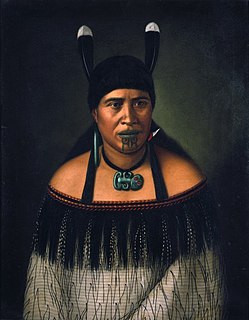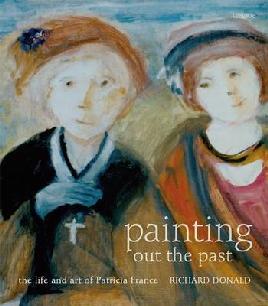
The Treaty of Waitangi is a treaty first signed on 6 February 1840 by representatives of the British Crown and Māori chiefs from the North Island of New Zealand. It has become a document of central importance to the history, to the political constitution of the state, and to the national mythos of New Zealand, and has played a major role in framing the political relations between New Zealand's government and the Māori population, especially from the late 20th century.
![Patricia Grace Writer (1937−[[Category:Errors reported by Module String]]String Module Error: Target string is empty)](https://upload.wikimedia.org/wikipedia/commons/thumb/4/4c/Patricia_Grace_in_2016_%28cropped%29.jpg/308px-Patricia_Grace_in_2016_%28cropped%29.jpg)
Patricia Frances Grace is a New Zealand Māori writer of novels, short stories, and children's books. She is a key figure in New Zealand literature and in Māori literature in English, and one of New Zealand's most celebrated authors. Her first published work, Waiariki (1975), was the first collection of short stories by a Māori woman writer. As of 2021, she has published seven novels, seven short story collections, several children's books and an autobiography. Her work is popular in New Zealand and internationally, and has been critically acclaimed.
Shona Rapira Davies is a sculptor and painter of Ngati Wai ki Aotea tribal descent. Currently residing in Wellington New Zealand.
Claims and settlements under the Treaty of Waitangi have been a significant feature of New Zealand race relations and politics since the Treaty of Waitangi Act 1975. Successive governments have increasingly provided formal legal and political opportunity for Māori to seek redress for breaches by the Crown of the guarantees set out in the Treaty of Waitangi. While it has resulted in putting to rest a number of significant longstanding grievances, the process has been subject to criticisms from a number of angles, from those who believe that the redress is insufficient to compensate for Māori losses, to those who see no value in revisiting painful and contentious historical issues. The settlements are typically seen as part of a broader Māori Renaissance.

Bastion Point is a coastal piece of land in Orakei, Auckland, New Zealand, overlooking the Waitematā Harbour. The area is significant in New Zealand history as the site of protests in the late 1970s by Māori against forced land alienation by pākehā.
Kura Te Waru Rewiri is a New Zealand artist, academic and educator of Ngāti Kahu, Ngāpuhi, Ngāti Kauwhata, Ngāti Rangi descent. In Te Puna, Māori Art from Te Tai Tokerau Northland, Deidre Brown writes, "Kura Te Waru Rewiri is one of Aotearoa, New Zealand's most celebrated Māori women artists."

Te Aitanga-a-Hauiti is a Māori iwi (tribe) on the East Coast of New Zealand's North Island. Its rohe covers the area from Tawhiti-a-Paoa Tokomaru Bay to Te Toka-a-Taiau Gisborne on the East Coast of the North Island of New Zealand.

New Zealand art consists of the visual and plastic arts originating from New Zealand. It comes from different traditions: indigenous Māori art, that of the early European settlers, and later immigrants from Pacific, Asian, and European countries. Owing to New Zealand's geographic isolation, in the past many artists had to leave home in order to make a living. The visual arts flourished in the latter decades of the 20th century as many New Zealanders became more culturally sophisticated.

Feminism in New Zealand is a series of actions and a philosophy to advance rights for women in New Zealand. This can be seen to have taken place through parliament and legislation, and also by actions and role modelling by significant women and groups of people throughout New Zealand's history. The women's suffrage movement in New Zealand succeeded in 1893 when New Zealand became the first nation where all women were awarded the right to vote. New Zealand was also the first country in the world in which the five highest offices of power were held by women, which occurred between March 2005 and August 2006, with Queen Elizabeth II, Governor-General Silvia Cartwright, Prime Minister Helen Clark, Speaker of the New Zealand House of Representatives Margaret Wilson and Chief Justice Sian Elias.
Robyn Kahukiwa is an Australian-born New Zealand artist, award-winning children's book author, and illustrator. Kahukiwa has created a significant collection of paintings, books, prints, drawings, and sculptures.
Emily (Emare) Karaka is a New Zealand artist of Māori descent Her work is recognised for "its expressive intensity, her use of high key colour, and her gritty address of political issues related to Māori land rights and the Treaty of Waitangi".
Alter / Image: Feminism and Representation in New Zealand Art 1973-1993 was an exhibition curated by Tina Barton and Deborah Lawler-Dormer to mark the centennial of women's suffrage in New Zealand. It showed at City Gallery Wellington from 1 August to 21 November 1993 and Auckland City Art Gallery from 17 December 1993 to 20 February 1994.
This is a timeline of the feminist art movement in New Zealand. It lists important figures, collectives, publications, exhibitions and moments that have contributed to discussion and development of the movement. For the indigenous Māori population, the emergence of the feminist art movement broadly coincided with the emergence of Māori Renaissance.
Star Gossage is a New Zealand painter. In addition to painting, her practice includes theatre, film-making, poetry, and sculpture. While referencing European movements such as expressionism, impressionism and surrealism, her work incorporates Māori concepts such as whānau and whakapapa.
Saffronn Te Ratana is a visual artist of Māori descent, born in Palmerston North, New Zealand. Te Ratana went to Palmerston Intermediate Normal School, followed by Palmerston North Girls’ High School.
Marilynn Lois Webb was a New Zealand artist, noted for her contributions to Māori art and her work as an educator. She was best known for her work in printmaking and pastels, and her works are held in art collections in New Zealand, the United States, and Norway. She lectured at the Dunedin School of Art, and was made an emeritus principal lecturer in 2004.
Charlotte Graham is a New Zealand artist based in Auckland. Her works are held at Auckland Art Gallery Toi o Tāmaki. Of Māori descent, Graham identifies with Ngāti Mahuta, Ngāi Tai ki Tāmaki, Ngāti Whanaunga, Ngāti Pāoa and Ngāti Tamaoho.
Roma Potiki is a New Zealand poet, playwright, visual artist, curator, theatre actor and director, as well as a commentator on Māori theatre. She is of Te Rarawa, Te Aupōuri and Ngati Rangitihi descent. As well as being a published poet, her work is included in the permanent collection of the Dowse Art Museum.

Patricia France was a New Zealand abstract artist. She took up painting in her mid-fifties as part of counselling and art therapy at a private psychiatric hospital in Dunedin. Her works became in demand in all leading New Zealand private and public galleries. She was noted for her unique, unmistakable paintings, as well as her independent charm and quiet flair.
Diane Prince is a painter, weaver, installation art practitioner and set designer and affiliates to the Maori iwi Ngā Puhi and Ngāti Whātua from the north of New Zealand.






![Patricia Grace Writer (1937−[[Category:Errors reported by Module String]]String Module Error: Target string is empty)](https://upload.wikimedia.org/wikipedia/commons/thumb/4/4c/Patricia_Grace_in_2016_%28cropped%29.jpg/308px-Patricia_Grace_in_2016_%28cropped%29.jpg)




